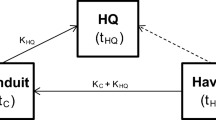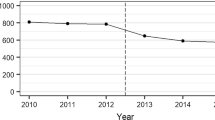Abstract
This paper reconsiders the role of interest deductibility for internal debt financing of multinational corporations (MNCs). We provide quasi-experimental evidence using restrictions on interest deductibility through thin-capitalization rules. Explicitly distinguishing between firms subject to a binding restriction and unrestricted firms, a panel data sample selection model is used to explore the tax sensitivity of the capital structure of foreign subsidiaries of MNCs. Our results confirm that the tax incentive for using internal loans is effectively removed for restricted subsidiaries. While internal debt financing of unrestricted subsidiaries positively responds to taxes, the effects are relatively small.
Similar content being viewed by others
Notes
For details, see Buettner et al. (2012).
Sec. 26 Aussenwirtschaftsgesetz (Foreign Trade and Payments Act) in connection with Aussenwirtschaftsverordnung (Foreign Trade and Payment Regulations). Each German multinational has to report its foreign assets, including both direct FDI and indirect FDI, conditional on some lower threshold level for mandatory reporting. Since 2002, FDI has to be reported if the participation is \(10 \,\%\) or more and if the balance-sheet total of the foreign object exceeds 3 million euros (for details, see Lipponer 2006). Though previous years showed lower threshold levels, we apply this threshold level uniformly in all years in order to avoid discrete changes in the sample selection.
In some countries where the safe haven debt-to-equity ratio refers to total debt, loans from financial institutions are not considered. However, our dataset does not allow us to distinguish between different sources of external debt.
In unreported placebo tests, we split our sample along the level of debt financing and do not consider host countries’ thin-capitalization rules. These additional tests, however, do not suggest that highly leveraged firms are generally insensitive to taxes.
See Table 1 in Buettner et al. (2012) for this information. The Kyriazidou (1997) estimator uses the first-stage estimation in order to define weights that are used for a second-stage weighted least squares regression. Since weights are determined specifically for each observation, we use two different sets of weights, depending on the specific type of rule in place in a host country. The coefficient vectors of the two estimations shown in columns (1) and (2) of Table 2 are then used to construct observation-specific weights (results are shown in columns (4) and (5) of Table 3).
Note that the fixed effects logit estimator removes all observations where no change in the regime is observed. As a consequence, the number of observations is relatively small.
Additional tests replicating columns (3) and (4) but using a first-differencing transformation suggest that the difference in the tax responsiveness between columns (4) and (2) is mainly related to the way how the unobserved affiliate heterogeneity is taken into account (first-differencing vs. demeaning of the equation) rather than to sample selection effects.
References
Arena, M. P., & Roper, A. H. (2010). The effect of taxes on multinational debt location. Journal of Corporate Finance, 16, 637–654.
Blouin, J., Huizinga, H., Laeven, L., & Nicodème, G. (2014). Thin capitalization rules and multinational firm capital structure. In IMF working paper 14/12.
Buettner, T., Overesch, M., Schreiber, U., & Wamser, G. (2009). Taxation and capital structure choice—Evidence from a panel of German multinationals. Economics Letters, 105, 309–311.
Buettner, T., Overesch, M., Schreiber, U., & Wamser, G. (2012). The impact of thin-capitalization rules on the capital structure of multinational firms. Journal of Public Economics, 96, 930–938.
Chamberlain, G. (1980). Analysis of covariance with qualitative data. Review of Economic Studies, 74, 225–238.
Chowdry, B., & Chowal, J. D. (1998). Internal financing of multinational subsidiaries: Debt vs. equity. Journal of Corporate Finance, 4, 87–106.
Desai, M. A., Foley, C. F., & Hines, J. R. (2004). A multinational perspective on capital structure choice and internal capital markets. Journal of Finance, 59, 2451–2487.
Feld, L. P., Heckemeyer, J. H., & Overesch, M. (2013). Capital structure choice and company taxation—A meta study. Journal of Banking and Finance, 37, 2850–2866.
Gopalan, R., Nanda, R., & Seru, A. (2007). Affiliated firms and financial support—Evidence from Indian business groups. Journal of Financial Economics, 86, 759–795.
Huizinga, H., Laeven, L., & Nicodème, G. (2008). Capital structure and international debt shifting. Journal of Financial Economics, 88, 80–118.
Kyriazidou, E. (1997). Estimation of a panel data sample selection model. Econometrica, 65, 1335–1364.
Lipponer, A. (2006). Microdatabase direct investment—MiDi. A brief guide. In Bundesbank working paper, Frankfurt.
MacKie-Mason, J. (1990). Do taxes affect corporate financing decisions? Journal of Finance, 45, 1471–1493.
Mintz, J., & Smart, M. (2004). Income shifting, investment, and tax competition: Theory and evidence from provincial taxation in Canada. Journal of Public Economics, 88, 1149–1168.
Overesch, M., & Wamser, G. (2010). Corporate tax planning and thin-capitalization rules: Evidence from a quasi-experiment. Applied Economics, 42, 563–573.
Schindler, D., & Schjelderup, G. (2012). Debt shifting and ownership structure. European Economic Review, 56, 635–647.
Wamser, G. (2014). The impact of thin-capitalization rules on external debt usage—A propensity score matching approach. Oxford Bulletin of Economics and Statistics, 76(5), 764–781.
Weichenrieder, A. J., & Windischbauer, H. (2008). Thin-capitalization rules and company responses—Experience from German legislation. In CESifo Working Paper 2456, Munich.
Acknowledgments
Data access by the Deutsche Bundesbank and financial support by the German Science Foundation (DFG) are gratefully acknowledged.
Author information
Authors and Affiliations
Corresponding author
Appendix: Datasources and definitions
Appendix: Datasources and definitions
-
Micro-level data are taken from the micro-level dataset (MiDi) of the Deutsche Bundesbank (see Lipponer 2006 for an overview). Internal debt is defined as liabilities to shareholders/affiliated enterprises/enterprises linked through participating interests. The share of internal debt is determined by the level of balance-sheet internal debt divided by total capital consisting of nominal capital, capital reserves, profit reserves, and total debt. Asset tangibility is defined as the ratio of fixed assets to balance-sheet total.
-
Corporate taxation data are taken from the International Bureau of Fiscal Documentation (IBFD) and from tax surveys provided by Ernst&Young, PricewaterhouseCoopers (PwC), and KPMG. The statutory tax rate variable contains statutory profit tax rates modified by restrictions on interest deduction—as in the case of the Italian IRAP.
-
Thin-capitalization rules Details on the type and tightness of thin-capitalization rules for all countries and over time are taken from Buettner et al. (2012).
-
Lending rates refer to private sector debt taken from the IMF International Financial Statistics Yearbook (2006) augmented with corresponding OECD figures.
Rights and permissions
About this article
Cite this article
Buettner, T., Overesch, M. & Wamser, G. Restricted interest deductibility and multinationals’ use of internal debt finance. Int Tax Public Finance 23, 785–797 (2016). https://doi.org/10.1007/s10797-015-9386-8
Published:
Issue Date:
DOI: https://doi.org/10.1007/s10797-015-9386-8




